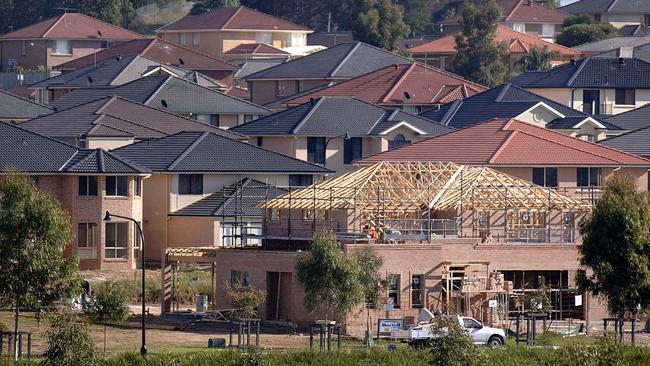How to play the property market amid rising interest rates: James Kirby
Residential real estate took a hit in 2022, but in late 2023 it may start to recover. Here’s how to play the market.

When is a good time to buy property? ‘It’s always a good time’, says your local real estate agent. ‘Surely, you wouldn’t buy now with so much to worry about’, says just about everyone else.
Here’s the reality: Property investing is long term, there are always opportunities. What’s more, whatever else may be the case, Australian residential property is now much cheaper than a year ago.
For both potential home buyers and property investors, the game has changed: Prices are falling, and the consensus is that they will keep falling for many months to come. At the same time, interest rates keep rising.
So, it is a more challenging environment. If you look at the facts – property prices have fallen from their peak in late 2021 by around 6 per cent to the end of 2022. If you listen to the forecasters – even the RBA – you can get forecasts suggesting the top to bottom decline might be as much as 20 per cent.
But the ‘base case’ for the RBA is an 11 per cent drop, which finishes in late 2023.
Now, the outstanding issue is that either a lot of bad news is going to come rolling down the track in the next few months or some leading forecasters have been too gloomy by far.
One intriguing aspect of the downturn to date is that until very recently it has shown none of the traditional signals we get in a dramatic slump. For example, you might think the numbers inside the big banks are showing real signs of stress by now on property. But the last two big banks to report – Westpac and NAB, showed almost no evidence whatever that mortgage stress was rising.
Every property downturn is different, and this one has some outstanding characteristics that analysts suggest must be understood by anyone entering the market.
Yes, we face higher rates- and importantly – higher inflation. But the serious property downturns in Australian history have always been accompanied by serious upturns in unemployment. This time around we do not have that problem; For homeowners that is a reassurance suggesting the decline in prices will remain ‘orderly’ until we reach the bottom.
Since we have only the merest hint of mortgage stress that indicates distressed sales – or headlines where homeowners are throwing in the keys and giving up on the market – are nowhere to be seen.

Along with the absence of these traditional signals of a downturn, there are new factors on the horizon:
For investors, the outstanding features of this market is that you can rent almost anything: The vacancy rates (which tell us how much property is empty at any given time) are among the lowest on record. This holds for both the big cities and the regional towns. If you take the plunge to buy investment property, then one of the biggest risks – that you will lose rental income through a lack of tenant demand – is virtually off the table in 2023.
So, for those who must buy property – such as first time home buyers – or those who want to invest, the challenge is to find where value might be appearing.
Financial advisers suggest you need to hold a property for 7 to ten years to get the optimum return.
In the pandemic era in boom, we saw property prices fly higher. But inside those numbers, it was stand-alone homes (and their promise of isolation from Covid) that really soared ahead. Units – especially apartments – were much less popular for the same reasons. No wonder then that stand-alone house prices rose much faster than apartments.
But so far in this downturn we have seen the opposite occurring: Units are falling at roughly half the pace of house prices and that is expected to continue, largely because house prices overshot during the upturn.
From an investor perspective, apartments are easier to purchase for the simple reason they tend to be cheaper and less maintenance than homes – long term they may not do as well in terms of capital increases, but value opportunities rarely appear in our market, especially at the ‘entry level’.
The other ‘swing factor’ facing property buyers in the coming year will be the impact of increased immigration on the residential market: Higher immigration is most likely to favour property in the major cities, where the jobs opportunities tend to be clustered.
Immigrants will traditionally begin their accommodation history in the apartment market before later purchasing a house. This is another positive for the apartment market.
Where to buy? The remarkable aspect of the pandemic era mini boom was the rush to the regions, which saw red-hot property markets in unlikely locations such as Canberra and Hobart. Regional towns such as Geelong or Wollongong had the most buoyant markets seen in decades as metropolitan centres lost favour.
Analysts suggest there may be a swing back towards the larger cities as the economy reverts to ‘normal;’. There is also the issue that in regional towns ‘supply of accommodation can be fixed relatively easily compared to a lack of supply in larger cities such as Sydney and Melbourne.

In fact, Sydney was the first city where prices began to fall in 2022 – it was also the city where price fell fastest. On that basis alone, real estate experts point to Sydney as the city that will recover first when the market eventually turns.
If you are ready to make a move in property for the long term, the other key issue is finance: Or to be more precise in the current climate: Finance, tax and incentives.
Nobody knows how high rates will go, but again, if the consensus has it correct, then we may reasonably expect variable mortgage rates to hit 8 per cent at the top of the current cycle.
Whether you’ fix’ or not at these levels is up to you: Suffice to say that fixing when mortgage rates were at 2 and 3 per cent was a very good idea, and at The Australian we constantly recommended that anyone who wanted to fix should do so at that time.
Knowing the forecasts for rates at this point in time, the number of people fixing will be only a fraction of the levels seen in 2021.
In relation to tax, the outlook should be relatively stable: The Albanese government has said it has no intentions of going near either negative gearing -where you can get tax deductions for your expenses on property that are above the income from the property- or on capital gains tax discount. Your home is capital gains tax-free, your investment property is liable for CGT, but it gets a 5o per cent discount if you hold it for more than a year.
For home buyers there are so many grants both federal and state based it is hard to keep track – there are also variations on taxes state by state.
But the most popular nationwide federal incentive is the government’s home deposit scheme – this is where as a first time homebuyer you can buy a house with as little as 5 per cent deposit and the government guarantees the other 15 per cent so that you can make the purchase which invariably requires a 20 per cent deposit at any bank.
There is also a first home super savers scheme, which allows first time buyers to access their super in very limited ways to put against a first home mortgage – this is useful to those who have a large salary and are ready to make a purchase. State incentives can be overlaid on Federal initiatives to get you over the line – a good mortgage broker or bank home loan specialist should be across all these issues.
At the other end of the spectrum, there are also incentives to help homeowners move out of the family home and get some extra money into superannuation. Until recently, if an empty nester did sell the family home and wanted to put the money into superannuation they had to abide by age-base super rules – in other words, they might have been too old to make super contribution. Under the super downsizing scheme, anyone over the age of 55 who sells the family home and wishes to make a super contribution can do so under a variation to the old rules.
Which leaves us with the burning question – when will the residential property market turn? Nobody can tell you that for sure, but for home buyers, the time to get into the market is whenever you can ... your home is not an investment or a speculation – it’s your place to live, and the economics are different for the homebuyer. Over the long term, you will be better off buying than renting (history suggests).
If you are an investor then if the RBA says rates will peak at the end of 2023 then that might be a very good time to start bargain hunting.
*This feature is part of our summer investment bootcamp series. A podcast on this feature can be heard on The Australian’s Money Cafe podcast – Summer Bootcamp series.






To join the conversation, please log in. Don't have an account? Register
Join the conversation, you are commenting as Logout